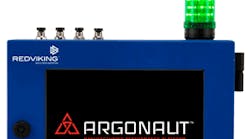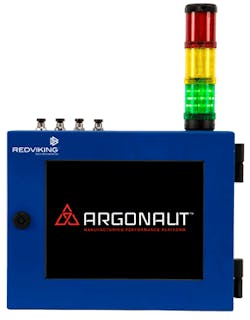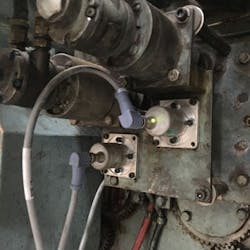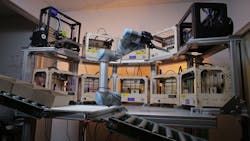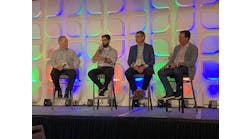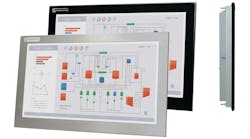New technology pushes machine smarts to the edge
With the advent of the Industrial Internet of Things and Industry 4.0, the use of smart edge devices is becoming more common in factory automation. A wide variety of these smart edge devices are being used for data collection and control, but what exactly one is depends on who you ask. Smart edge devices don't necessarily make a smart machine.
What exactly is a smart edge device? What real work are these computing devices and microcomputers doing at the edge? And do these smart edge devices make machines smarter and improve manufacturing?
Taking a step back from the edge, Rich Carpenter, general manager controls platforms, GE Automation and Control asks, "In today's modern era, are smart edge devices re-defining the traditional control loop that has been in place for about 50 years? Collect your inputs, run your logic and set your outputs is how we have been doing it for a long time. In today's world and moving forward, you have to incorporate the results of analytics and optimization that happen outside of the normal control loop. The smart edge device is a critical link between what the traditional control system can do and the rich set of information available at the plant, enterprise and even the ecosystem level that can be incorporated into the day-to-day control decisions."
What is a smart edge device?
Figure 1: RedViking’s Spearhead smart edge device can be a hardened HMI, drive a display or function without a display.
(Source: RedViking)
"A smart edge device is something that’s able to communicate one or many plant-floor protocols in a way that isolates that network and traffic from the Internet," says Greg Giles, executive director, MES/Argonaut at RedViking in Plymouth, Michigan. "Sometimes data can be processed on the edge device; sometimes the edge device can simply be a pass-through. In both cases, it’s responsible for passing information to an enterprise- or cloud-level server."
The edge device that RedViking uses as part of its Argonaut Manufacturing Performance Platform is called a Spearhead (Figure 1). "Sometimes these more complex versions of a Spearhead are incorporated into a hardened HMI or drive some other type of external display," says Giles. "The simpler implementations are usually small devices without a display."
Smart edge devices perform information computing, such as data gathering, data storage and analytics, at the device level, says Mike Pantaleano, global business manager—analytics & cloud at Rockwell Automation. "These devices may have cloud gateway functionality, but what truly makes them smart is their ability to manage data and help drive decisions locally," he says.
Manufacturing systems have always used edge devices that are located close to or in contact with the workpieces or material, says Christian Fell, Posital-Fraba. "These include the sensors, actuators, drives and so on that provide real-time information to the control system and carry out its instructions," he says. "Smart edge devices are just devices that have some level of built-in intelligence, often in the form of an embedded microprocessor. These local microprocessors can perform tasks such as signal processing to turn analog readings into calibrated, temperature-compensated digital data; condition monitoring; and management of high-level communications interfaces such as fieldbus or industrial Ethernet."
ALSO READ: Where exactly is the network edge?
Control and analytics
Smart edge devices may provide control at the edge. "However, a larger use case for edge devices has to do with data analysis, which allows the device to perform some basic analytics onboard and off-line," says Keith Blodorn, director of the wireless program at ProSoft Technology. "The immediate value of this is reducing the torrent of data that would otherwise need to flow to an analytics engine in the cloud, since transporting that data remains the most expensive part of the big data puzzle."
That said, an edge device performs a mission-critical role in production at the edge, continues Blodorn, but a smart edge device takes this a step further by continuing to reliably function while offering secure enhanced access, control and visibility into that edge function and edge devices.
Smart edge devices can be used for both the control and monitoring of industrial machines and equipment, notes Nick Butler, Sr., group manager, data acquisition & control product marketing at National Instruments. "The purpose of the edge device is to make the asset itself smart," he says. "This is done by connecting the asset to the network and allowing the asset to sense and react to its own operating conditions and environment. This results in assets that are not only smarter, but safer, more reliable and better performing."
At National Instruments, smart edge devices must have the following features or capabilities:
- ability to interface with sensors to measure conditions inside of and around the machine
- ability to interface with actuators or other motion systems to control the operation of the machine based on input from the sensors
- connectivity to other devices in the deployment environment, such as fieldbuses, other machines and SCADA systems, as well as connectivity to the IT/enterprise network, so that the asset becomes a “thing” on the network that can be remotely monitored, managed and controlled
- durability and a rugged enough exterior to withstand the conditions of a factory or industrial environment
- internal processing and analysis capabilities to process incoming sensor data and make decisions or control outputs at the asset.
Control, data and smartphones
"The set of possible smart edge devices that can be used for industrial control is rapidly expanding as ever more compute and sensing capability moves to the edge," says Greg Olsen, senior vice president, products, at Falkonry. "As long as the device can transform signal observation into operational commands or guidance, it can be considered a control device. Smartness is clearly subjective, but the range can include anything from advanced process control all the way up to artificial intelligence."
A smart edge device enables communication between operators and ICS/SCADA systems in near real-time, without disrupting, interrupting or altering existing networks and device configurations," says James Scott, senior fellow, Institute for Critical Infrastructure Technology (ICIT). "Many smart edge devices are able to make coordinated decisions even in low-bandwidth settings or on unreliable networks."
A smart edge device is some type of connected industrial device designed to gather large amounts of manufacturing data and to have the flexibility to process data or conduct analytics on the device, says Eric Reiner, industrial PC market specialist at Beckhoff Automation. "This same device must also be able to transmit data vertically to the cloud or other higher-level database systems, such as MES or ERP," he says. "In terms of the Beckhoff portfolio, these include PC-based controllers, such as compact industrial PCs and embedded PCs that can conduct advanced analytics at the machine and/or push data up via recognized IoT standards such as OPC UA, MQTT and AMQP."
Edge devices are generally routers or switches that act as a portal for machines to the outside world, says Tom Moolayil, senior technical manager at Universal Robots. "Smart edge devices, in this case, would be smartphones, tablets, car, TV and other devices that are Internet-enabled," he says. "These devices would have access to the factory floor via standard edge devices, so in tandem I suppose you could refer to them as a smart edge device. The reason it's smart is it gives unprecedented and easy access to the factory floor."
Some key smart features
"Smart devices alone don’t automatically make machines smart," says Rockwell Automation's Pantaleano. "A machine requires controllers to orchestrate the proper sequence, turn things on and off at the right time and survey various conditions to optimally control production. In this way, the controller adds a critical layer of context in addition to its control responsibility."
One example is Rockwell Automation’s upcoming Allen-Bradley CompactLogix 5480 controller, which will have Windows 10 built right into it, continues Pantaleano. "This will create a marriage of mission-critical control with analytics and information," he says. "New software tools can help to bring analytics to existing edge devices. For example, our new FactoryTalk Analytics for Devices appliance can provide analytics on devices such as drives to transform them into smart edge devices."
New mobile apps are turning the everyday smartphones in our pockets into smart edge devices, states Pantaleano. "Our FactoryTalk TeamOne mobile app, for example, allows smartphones to be securely added inside the IT network and automation layer rather than coming in from outside Internet," he says. Already today, industrial companies are using this app to diagnose issues, collaborate with colleagues and instantly connect to automation devices (Figure 2)."
Figure 2: A mobile app turns a smartphone into a smart edge device that can connect to automation devices, diagnose issues and collaborate with colleagues.
(Source: Rockwell Automation)
The next generation of the control loop will have an inner and outer loop, says GE Automation and Control's Carpenter. "The inner loop is the traditional read inputs, do logic and set your outputs," he says. "The outer loop will gather the intelligence and smart information to make better decisions. This is what drives the need for a smart edge device."
For brownfield, existing applications, GE has an outer loop smart edge device called a Field Agent—a secure authenticated device that can connect into other information, run analytics and send the information to the control to make better decisions, continues Carpenter. "For a greenfield application, GE has a two-in-one programmable automation controller (PAC) called the RX3i CPE400," he says. "Part of the controller's processor is used for deterministic control, and part is used for implementation of the field agent. This is a connected controller smart edge device that can run the inner and outer loop, simultaneously. The industrial Internet control system (IICS) has arrived."
Other key features include the connection and user interface. "Smart edge devices typically have a serial/Ethernet port or a wireless connection, it may include a TCP/IP stack, and it contains a mechanism for remote users to connect to the smart device using device capable of hosting a, typically HTML5, Web browser," notes ICIT's Scott. "Authenticated users can monitor or adjust the system settings through configurable rich graphical interfaces," he says. "Many smart edge devices do not require proprietary code/ firmware, contain extensive object libraries and have built-in GUI functions."
Hilscher defines the edge as that point of contact where OT control environments connect to IT environments, says Craig Lentzkow, IIoT business development manager at Hilscher. "Hilscher Edge Gateways make the connectivity between OT and IT environments," he says. "Depending on the product, the Edge Gateways can run customer applications on them to facilitate edge computing, or only stream data from the manufacturing floor to servers, on premise or in the cloud."
Why be smart?
"There are new IIoT devices designed every day," says RedViking's Giles. "We’ve had decades of experience customizing MES, incorporating multiple brands of controllers and software and networks, and, if you’re a very large corporation with millions invested in your legacy systems, you don’t have much choice but to keep recoding that black-box MES software. That’s the whole reason we developed Argonaut. It’s designed to be an anything-to-everything platform. It can receive data from any plant-floor machine or device and send it to anything that can receive an API call. Manufacturing companies won’t have to write new code for every new device or software application, and they won’t be tied to any specific type of equipment. Smart devices are important to the future of manufacturing data, but we believe that flexible software is just as important, if not more so."
An important reason for building intelligence into an edge device is to off-load tasks from the central controller hardware and have the work done by the edge device, says Posital-Fraba's Fell. "This can be achieved by using higher-level communications systems such as fieldbus or industrial Ethernet," he says. "These systems, which make use of local microprocessors or ASIC devices to manage the interface, take care of data communication tasks, such as data packaging, handshakes and error-checks, without burdening the central PLC or microcontroller."
The two advantages to using a separate edge device for collecting and analyzing data are avoiding load on the PLC processor and providing a configuration paradigm that is geared toward data management rather than machine control, says ProSoft Technology's Blodorn. "As it relates to machine control, the PLC is an edge computer," he says. "With the tremendous growth in machine analytics, some of these edge data collection tasks will surely fall on the PLC, while others will find better homes in other devices throughout the system."
Smart edge devices, such as smart instruments, are especially important for process skids, where the system may be installed in a remote area or not connected to the main control system, says Michael Robinson, national marketing manger, projects, services and solutions, at Endress+Hauser. "Data and analytics from the smart instruments can be sent directly to a plant’s control systems or operators without involving the skid’s control system."
How to use them
Figure 3: Smart encoders monitor equipment position on a machine as part of an updated control system.
(Source: Chicago Electric)
"Using our Argonaut platform, smart device data is captured on a Spearhead edge device and forwarded to a server or the cloud," says RedViking's Giles. "It’s all managed from a central location, with apps and updates deployed as needed. It’s efficient because it doesn’t require a plant-floor PC to run or an on-site engineer to perform updates. It’s secure because it uses TLS, token-based authentication."
Another example of a smart edge device starts with a control system upgrade, by Chicago Electric, in Carol Stream, Illinois, using standard PLCs, drives, sensors and HMI screens. Chicago Electric builds control systems for a variety of applications, including the corrugated container industry. "When a component needs to be replaced or some new functionality is required, updating the old software can be a nightmare," explains Bob Kaska, Chicago Electric’s president. "A control system upgrade frees our customers from the limitations of proprietary components and software.
The task of measuring the precise location of machine components is handled by smart absolute encoders, says Kaska. “Posital absolute encoders have been a key part of our design philosophy since 2008,” he says. “They provide a complete picture of exactly where each component of the machine is positioned, even after a power failure or cold startup. More than 500 Posital encoders have been built into Chicago Electric control systems (Figure 3). The available EtherNet/IP interface supports both operational data communications and full device condition monitoring."
Making robots smarter
"In essence, a smart edge device is a tool that sits on the edge of your private network and allows it to connect to external resources, including the cloud," says Eric Foellmer, chief marketing officer at Tend.
"We use a smart edge device, called a sidekick, as part of our smart cloud robotics software solution, in.control," explains Foellmer. "The device essentially acts as a router, which connects any robot to our cloud-based control system," he says. "The user can now control and monitor a Universal Robot, for example, that is tending 3D printers or CNC machines from anywhere using a secure software app on a smartphone (Figure 4). This is a smart edge device using Smart Manufacturing/Industry 4.0 principles today."
Figure 4: A smart edge device with smart cloud robotics software and a vision system enables a robot to interact with machines as a human would.
Source (Tend.ai)
The in.control software and sidekick also give the robot smart vision. "Using a vision-based approach to interfacing with machines is actually a more versatile and forward-thinking approach, for a number of reasons," says Foellmer. "First, there are many older production machines in use today which can’t be feasibly connected or integrated via a physical network. Our solution leverages the customer’s own cameras to interface with those machines visually, like a human would. For example, it can read a display screen, check on part status or look for errors."
More importantly, this approach is a more versatile way of interacting with machines in general. "It overcomes the fact that there are so many different networking protocols, proprietary software interfaces and other variables to contend with when integrating directly between machines," explains Foellmer.
The one thing that all machines have in common, new and old, is that they were designed to interface visually with human beings, says Foellmer. "Because our system interacts with those machines in that way, it eliminates the need to have a standard technology platform that creates those connections," he says. "So by leveraging a vision-based approach, the robot responds to those visual prompts in the way a human would, and the way it’s been instructed to during the training process—that is, 'part not ready; move to the next machine.'"
Software makes the edge smart and connected
"One of the main advantages of choosing a software-plus-edge-device approach is that data and configurations aren’t lost in the event of some kind of interruption," says RedViking's Giles. "Data is sent from the edge device and stored centrally, so if the plant has some kind of hardware or network failure, they’ll be able to quickly restore normal operating conditions. All of the data and configurations are centrally managed and deployed."
Another important benefit of smart edge devices is their flexibility and versatility. "The performance characteristics of a smart device can be largely defined in software," says Posital-Fraba's Fell. "For example, the current generation of Posital's incremental encoders can be programmed to have a resolution—number of pulses per revolution (PPR)—anywhere between 1 and 16,384 PPR," he says. "There is no need to make mechanical changes to the device. This is useful for system designers, since they can specify exactly the performance characteristics they need, without compromise."
We have examples of smart edge gateways collecting real-time data of manufacturing processes from one to more than 30 plants, says Hilscher's Lentzkow. "Data is brought to one centralized location via a software platform running in each plant," he says. "The platform provides process visualization and sends data in MQTT format to IT software. The Hilscher Edge Gateways connect to the machines collecting process data and the software platform also runs in the Edge Gateways providing the IT connectivity (Figure 5)."
Figure 5: In this diagram, the gateway is a computing device that collects data from real-time control networks and converts it to protocols that can be interpreted by IT software.
(Source: Hilscher)
Past, present and future
"How can smart devices connect and communicate on a plant floor, to a controller and to the cloud, all efficiently and securely," asks Daniel McGinn, director of business development, SecurePower—IT Business at Schneider Electric. "This is the ultimate question. We are already sitting on a mountain of untapped data and capability. Smart devices and open networks have been finding their way into industrial applications since the early ’90s, often unconnected or only connected in a hierarchical way to upstream controllers."
While we hear one conference presentation after another and see new articles everyday about the benefits of smart devices, the Industrial Internet of Things, Industry 4.0 and Big Data for Manufacturing, we often ignore the longstanding reasons that there have been specifications in place to prevent that very type of open connectivity, continues McGinn. "Concerns such as uncontrolled access, network intrusion, cybersecurity and system management become front and center in such an enterprise," he says.
“We used to install these systems and effectively forget about them for years,” notes McGinn. "In an open and connected environment, edge infrastructure needs to be managed and maintained in much the same way as IT systems, but with additional consideration since we are talking about physical systems that can cause harm to themselves or product or even people if not managed properly. Policies, practices and system architectures need to be aligned around these needs. This means specifying high-availability hardware, including network redundancy and UPS backup, much like in IT environments. It also means having strategies for software deployment, patch management, anti-virus and, quite possibly, virtualization."
The future trend will be to push the data analytic engines from the edge devices down to the actual devices themselves, says Nathan Hedrick, national product manager, flow, at Endress+Hauser. "There are two objectives that the sensor and its associated data are fulfilling," he says. "First is to control the process, and that will need to be performed by a supervisory element outside the device, and, second, to ensure that the measurements and devices are healthy and performing optimally."
These smart edge devices will bring the business thinking to the way your equipment runs and get a better outcome for your organization, says GE Automation and Control's Carpenter. "A whole series of apps will be available to be operated on the various edge devices," he says. "The creativity will be through the industrial community to deliver value-added applications. Find the app that works best for the application, download it and run it."
The smart edge devices will help to fuel the app economy for control that doesn't really exist today. Security is the most important concern. “But you also don't want some errant app to adversely affect the way a machine runs," says Carpenter. "The rules for interacting have been defined," he says. "The deterministic side needs to be perfect all the time, and the smart-edge-device side, such as a Field Agent, uses dialog and negotiation to keep the operators and equipment safe and optimized."
